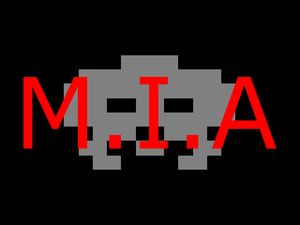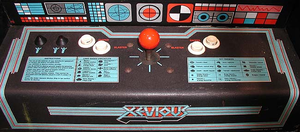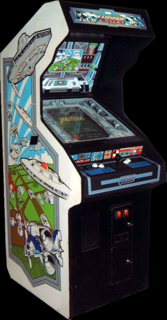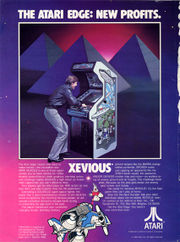Lost In Translation/Xevious
| Xevious | |
|---|---|
| Manufacturer | Namco |
| Released | 1982 |
| Control Method |
8-way Joystick 2 Button(s) |
| Main CPU | (3x) Z80 (@ 3.072 MHz) MB8842 (@ 256.000 kHz) MB8844 (@ 256.000 kHz) |
| Sound CPU | Mono Namco (@ 96.000 kHz) Discrete |
| Video Details |
Raster (Vertical) 288 x 224 pixels 60.61 Hz 1,152 Palette colours |
| Screens | 1 |
| ROM Info | 29 ROMs 93,440 bytes (91.25 KiB) |
| MAME ID | xevious · battles · sxevious · xevios · xeviousa · xeviousb · xeviousc |
About The Game
Xevious is a vertically scrolling arcade video game shoot-em-up in which the player pilots a combat aircraft called a 'Solvalou' armed with a forward-firing gun for aerial targets, and bombs for destroying ground-based targets.
A red targeting square is situated in front of the Solvalou, which allows the player to aim their bombs accurately. The enemy craft appear in a number of different guises; from the standard variety that arrive in large numbers but shoot slow-moving projectiles, to exploding black spheres that shoot projectiles at high speed. There are also rotating shields that cannot be destroyed and must be carefully avoided. Ground enemies are a combination of both stationary bases and moving vehicles, most of which fire slow-moving projectiles. A gigantic, floating fortress (called 'Andor Genesis') appears in certain areas; this is defeated by knocking out its core.
Xevious is actually divided into 16 different areas, which are separated by an area of forest. If a player dies before less than 70% of an area has been completed, play restarts at the beginning of the same area; should a life be lost AFTER 70% of an area has been completed, however, play restarts at the beginning of the next area. After area 16 has been completed, the game loops back to area 7.
Additional Technical Information
Players : 2
Control : 8-way joystick
Buttons : 2
= > [1] Zapper, [2] Blaster
Trivia
Released in December 1982.
Licensed to Atari for US manufacture and distribution (January 1983). Approximately 5,295 units were produced by Atari.
Xevious IS NOT the world's first vertically scrolling shoot-em-up but has a huge and lasting influence on the genre. Xevious was the first games to use pre-rendered graphics and, among its countless innovation, was also the first vertically shoot-em-up that allowed accurate targeting of both air-born AND ground-based enemies. The graphics were hugely revolutionary for their time; the sprites were rendered with remarkable clarity and detail due to the game's celver use of colours and shades as well as palette-shifting. Xevious was also the first game to feature 'hidden characters', which, being hidden, are not mentioned in the game's instructions but can be revealed by performing a secret manoeuvre. Among these was the 'special flag', which gave the player an extra life. This feature was carried over to a number of subsequent Namco games.
While Xevious enjoyed limited popularity in the U.S., the game was a huge cult hit in Japan, and to this day is considered one of the greatest video-games of all time. Popular Japanese musicians, Haruomi Hosono (Yellow Magic Orchestra) and Kuwata Keisuke (Southern All Stars) were known to be fans of the game, and the former produced an album of music from Namco video-games; with Xevious as its centrepiece. A follow-up 12in. single featured in its liner notes an entire science-fiction short story by Endoh, set in the world of Xevious, which even included a rudimentary fictional language.
At one point in the game, the Solvalou flies over the Nazca lines. The Nazca Lines are geoglyphs (drawings on the ground) located in the Nazca Desert; a high, arid plateau that stretches thirty-seven miles between the towns of Nazca and Palpa, situated in the Pampa region. They were created during the Nazca occupation of the area, between 200 BC and 600 AD.
Cast Of Characters
- Air Units
These are the air units you will encounter during the game. Depending on a players skill will determine what air units they may face: -
- Andor Genesis (mother ship) - The large ship in areas 4, 9, and 14.
- Bacula (resistor shield) - The large rotating floating walls which are indestructible.
- Brag Zakato (energy blaster) - Medium black ball, with a red dot, that explode and send several shots at your Solvalou.
- Bragza (crystal) - the crystal core of the Andor Genesis mother ship which escapes upon its destruction.
- Garu Zakato (energy bombarder) - Large black ball that explode sending out a multitude of shots in all directions.
- Giddo Spario (energy blast) - Small, white crystal-like projectiles that come in diagonally at your Solvalou.
- Jara (spinner) - Look like a UFO with a spinning gear in the middle.
- Kapi (deflector) - Flat looking fighter with two front projections that flies in, fires multiple shots, then escapes quickly.
- Sheonite (escort) - small spinning diamond-shaped craft which escort your Solvalou for a bit and fly off.
- Terrazi (destructor) - Flat looking, diamond shaped fighter that flies in, fires multiple shots, then escapes quickly.
- Torkan (scout ship) - Ridged fighter that flies in, fires one shot, then escapes quickly.
- Toroid (fleet) - Ring shaped fighter which is traditionally the first enemy you encounter.
- Zakato (energy launcher) - Small black ball that explodes sending a single shot at your Solvalou.
- Zoshi (death squad) - The round spinning fighter which can sometimes attack from behind.
- Ground Units
These are the ground units you will encounter during the game: -
- Barra (energy station) - Small pyramid-shaped buildings.
- Boza Logram (dome network) - A structure of four Lograms surrounding a Derota.
- Derota (defence site) - The small octagonal-shaped gun batteries that fire multiple shots at your Solvalou.
- Domogram (rover) - It looks like a mobile Logram that travels along the roads and fires shots at your Solvalou.
- Garu Barra (energy base) - Medium and large pyramid-shaped buildings.
- Garu Derota (mega site) - The large octagonal-shaped gun batteries that fire multiple shots at your Solvalou.
- Grobda (tank) - The tank-like vehicles that travel along the road. They can detect when your bombsight is on them and they will move out of the way.
- Logram (sphere station) - Silver circular domes that fire single shots at your Solvalou.
- Sol (citadel) - Underground structures which rise up when initially bombed.
- Zolbak (detector dome) - Domes with red squares on top and around their base.
The graphics ROMs contain several additional enemies which don't actually appear in game-play including a silver-grey Galaxian flagship. These enemies do appear in the game-play of "Super Xevious" which uses the same graphics data as Xevious.
The highest score possible is 9,999,990, at which point the game terminates abnormally and resets. Some time before this score is reached, the game starts to award extra ships on every blaster shot fired.
Marco Borroni holds the official official record for this game with 7,009,560 points (!) on 08/16/1984.
The background is actually one large 1024x2048 image. Each of the 16 game areas is a 224x2048 strip starting at a different horizontal offset in the image.
Two bootlegs of this game are known as "Xevios" and "Battles".
In 1982, Atari released a set of 12 collector pins including : "Missile Command", "Battle Zone", "Tempest", "Asteroids Deluxe", "Space Duel", "Centipede", "Gravitar", "Dig Dug", "Kangaroo", "Xevious", "Millipede" and "Food Fight".
Updates
- The high-score name are 3 characters long on the version licensed to Atari. It's 10 characters long on the version manufactured by Namco.
- The zapper and blaster buttons were reversed between the Japanese and US versions.
Scoring
Scoring in this game is relatively complicated due to all the different units.
| Target | Points |
|---|---|
| Andor Genesis | 1,000-4,000 |
| Brag Zakato | 500 |
| Garu Zakato | 1,000 |
| Giddo Spario | 10 |
| Jarra | 70-100 |
| Kapi | 300 |
| Terrazi | 700 |
| Torkan | 50 |
| Toroid | 30 |
| Zakato | 50 |
| Zoshi | 100 |
| Target | Points |
|---|---|
| Barra | 100 |
| Boza Logram | 2,000 |
| Derota | 1,000 |
| Domogram | 800 |
| Garu Barra | 300 |
| Garu Derota | 2,000 |
| Grobda | 400 |
| Logram | 300 |
| Zolbak | 200 |
Specials (see Tips and Tricks below for how to get them)
- Flag : 1000 points for uncovering it, bonus Solvalou for flying over it
- Sol Citadel : 2000 points for making it surface - 2000 points for destroying it
Tips and tricks
When you start the game, your Solvalou will be at the bottom of the screen. Keep in mind, this is a scrolling game. This means you can go no faster than the top and no slower then the bottom of the screen. You can, however, vary your speed in-between by pushing the joystick up and down. The biggest key in getting through this game is learning how to use the joystick to speed up and slow down because you will sometimes be put into some very tight areas that will require precision joystick control.
- One interesting aspect of this game is the fact if you are too successful against a particular kind of enemy, the game will adjust itself to send different enemies until you have difficulty dealing with them.
- Make sure you know what you will be encountering in each area.
- If you hold down the fire and bomb buttons, you will constantly be doing both at a slower rate. This is great when you are in the thick of things with both air and ground targets swarming the area.
- Speaking of bombs, your Solvalou is equipped with smart bombs (so to speak). They are launch and forget weapons. When you 'paint' the target with your bomb-sight and launch your bomb, it will hit that target even when you have already flown over it. There are a couple of strategies to make your bombing runs more effective :
- When you have targets close together (usually gun batteries are arranged this way), put a bomb between them. You will have a very good chance of taking out both batteries with one hit since you can only have one bomb on the screen at a time.
- For moving targets (such as tanks), anticipate the targets direction and 'lead' it a little. This basically means putting the bomb at the point where the target will run into it.
- Your bomb-sight will turn red whenever any target is 'sighted', even if the target is hidden like Sol Citadels and flags.
- Keep away from the corners. These can become death traps real quickly if you are swamped by enemies.
- Since you have free reign of most of the screen to move around, make sure you use all that room for manoeuvring. Enemy fighters have a nasty habit of either shooting from behind your fighter or re-entering the screen from random sides. It also is handy when you are dodging a heavy volume of enemy fire.
- Make sure when you are manoeuvring around the rolling plates, you always leave yourself a clear 'out'. What I mean by this is there another direction to escape instead of having to move along with the plates. An occasional enemy likes to put up shots at your fighter since it is very difficult to manoeuvre around the rolling plates.
- The Andor Genesis Motherships are pretty easy to destroy if you work quickly. Most of the time, Zakatos and Brag Zakatos precede the arrival of the Andor Genesis Mothership. Blast these out of the sky and avoid the shrapnel. When the Andor Genesis Mothership appears, lead the target a little and quickly move up and plant your bomb at the point the centre of the ship will be. The less time you waste taking on this ship, the better.
Secret Message
The designer of Xevious has included a trick for generating his name right at the beginning of the game. As soon as Solvalou appears, move to the far right edge of the screen and begin bombing constantly. Continue bombing until the first set of attacking rings is very close to you and then shoot the rings. The message 'Namco ORIGINAL Program by EVEZOO' will appear on the screen.
The Flags
There are four flags hidden throughout the game. These flags occur in areas 1, 3, 5, and 6. All flags are along a horizontal line across the terrain. The only way to uncover a flag is to bomb it so you will have to lay a string of bombs along the entire horizontal line. This basically means moving up quickly, dealing with enemies quickly, and dropping your bombs quickly. Once a flag is uncovered, you must fly over it to get the benefits from it.
- Flag 1
The first flag is located in the first river you encounter after you start the game. Look for the three Grobdas in a row. Just above them is a river that cuts horizontally across the terrain. Just bomb the river from left to right and around the bank closest to you. The flag should appear.
- Flag 2
After you get past the plates, look up and to the right. There is a little lake with a small river feeding into the ocean. Start in the middle of the lake and bomb toward the little river. The flag should appear around where the river dumps into the ocean.
- Flag 3
When you cross the first ocean, you will eventually see a dock/harbor at the top. The flag is located around the horizontal line that the longest pier projecting out is part of. You will need to quickly bomb that entire length to find and get the flag before the bottom scrolls your Solvalou too far up.
- Flag 4
You will see a big bird picture on the desert. At the lowest point of its tail-feathers (in the lower right corner), start to bomb horizontally from right to left. The flag will appear.
Sol Citadels
These structures require you to bomb them once to cause them to surface. They look like large storage tanks or grain silos. You then need to bomb them again to destroy them. You have a potential to collect several hundred thousand points by taking out these structures. They come in groups of 1, 4, or 8. Unlike flags, these structures are always in the same place. There are six sets of Sol Citadels.
- First Set
One in area 2. When you see the three Grobdas in a row on the road, start laying bombs in the area around the cul-de-sac below the last tank in a right and diagonal-down point. The citadel will be even with the cul-de-sac.
- Second Set
One in area 3. When you see the Garu Bara, go to the left of the Garu Bara and start bombing. This is also the area that the second flag can be found.
- Third Set
Four in area 9. There is a clear area right before you tangle with the second Andor Genesis Mothership. Where the road splits around the woods, start to lay bombs a little below the bottom edge of the road that goes to the right. You should uncover four Sol Citadels.
- Fourth Set
Eight in area 13. At the point the desert ends, there is a little grass, then the air field starts. Use the birds leg as a reference and fly straight up. When the bomb-sight glows, start bombing. This will be the lower left Sol Citadel of the group which is arranged in two rows of four citadels. You will be hard pressed to get all eight citadels.
- Fifth Set
Four in area 14. After the plates roll by, look for where two roads merge into one road. At the top edge of the slanted right hand road, start dropping bombs to uncover some more citadels.
- Sixth Set
Four in area 15. Look for a forest on the left side. There will be a small clearing and then a river. Bomb the small clearing to bring the citadels up. There will be very intense ground fire in this location so be especially watchful.
Series
- Xevious (1982)
- Super Xevious (1984)
- Solvalou (1991)
- Xevious 3D/G (1995)
Staff
- From Hiscore Table
- Masanobu Endoh (Evezoo End)
- Masaya Nakamura (M.Nakamura)
- Eirry Mou
- Shin-ichiro Okamoto (S.Okamoto)
- Shin-ichi Kojima (S.Kojima)
- Music By
- Yuriko Keino
Cabinet and Artwork
Ports
- Consoles
- Atari 2600 (1983)
- Atari 5200 (1984)
- Nintendo Famicom (1988)
- Atari 7800 (1989)
- Nintendo Famicom Disk (1990)
- NEC PC-Engine (1990)
- Sony PlayStation (1996, "Namco Museum Vol.2")
- Sony PlayStation (1997, "Xevious 3D/G+")
- Nintendo Game Boy Advance (2004, Famicom Mini Series)
- Sony PlayStation 2 (2005, "Namco Museum 50th Anniversary")
- Microsoft XBOX (2005, "Namco Museum 50th Anniversary")
- Nintendo GameCube (2005, "Namco Museum 50th Anniversary")
- Sony PSP (2005, "Namco Museum Battle Collection")
- Computers
- Sharp MZ2500 (1982)
- Atari 800 (1984)
- Apple II (1984)
- Tandy Color Computer (1984, "Devious")
- Fujitsu FM-7 (1984)
- Commodore C64 (1986)
- Amstrad CPC (1986)
- Atari ST (1987)
- Sinclair ZX Spectrum (1987)
- MSX2 (1988)
- PC [MS Windows, CD-ROM] (1998, "Microsoft Revenge of Arcade")
- PC [MS Windows, CD-ROM] (2005, "Namco Museum 50th Anniversary")
- Sharp X68000
- Sharp X1
- Others
- Arcade (1995, "Namco Classics Collection Vol.1")
- Ms. Pac-Man TV Game (2004 - Jakk's Pacific)
- Ms. Pac-Man TV Game Wireless Version (2005 - Jakk's Pacific)
Soundtrack Releases
| Album Name | Catalogue No. | Released | Publisher | Comments |
|---|---|---|---|---|
| Video Game Music | YLR-20003[1] | 1984-04-25 | Alfa | Vinyl version. |
| Super Xevious (12" Single) | YLR-12002[2] | 1984-08-29 | Alfa | Double vinyl version. |
| The Best of Video Game Music | 32XA-66[3] | 1986-04-25 | Alfa | CD version. |
| This is NAMCO! | APCG-4006[4] | 1990-09-21 | Apollon | CD version. |
| 20th anniversary a TRIBUTE to GAME-sounds for music-CD | AYCM-610[5] | 1998-05-21 | Ayers | CD version. |
| Namcot Game a la Mode | VDR-1285[6] | 1986-09-21 | Victor Musical Industries | CD version. |
| Video Game Music | YLC-20003[7] | 1984-04-25 | Alfa | Cassette version. |
| Video Game Music | SCDC-00003[8] | 2001-03-23 | Scitron Digital Content, Inc. | CD version. |
| Namcot Game a la Mode | SJX-30312[9] | 1986-09-21 | Victor Musical Industries | Vinyl version. |
| Namcot Game a la Mode | VCH-10365[10] | 1986-09-21 | Victor Musical Industries | Cassette version. |
| 765 MEGA-MIX | APCG-4014[11] | 1991-07-21 | APOLLON | CD version. |
| NAMCO Classic Collection Techno Maniax | PCCG-00440[12] | 1998-02-18 | Pony Canyon, Inc. | CD version. |
| Namco Classics Collection Vol. 1 Arcade Soundtrack 010 | WSCA-00009[13] | 1998-01-21 | Wonder Spirits | CD version. |
| Namco Arcade 80's | SCDC-00272[14] | 2003-05-21 | Scitron Discs | CD version. |
| Super Xevious | SCDC-00099[15] | 2001-10-11 | Scitron Discs | CD version. |
| Legend of Game Music ~Premium Box~ | SCDC-00410~7[16] | 2005-03-24 | Scitron Digital Contents | 8 CD version. |
| Arcade Ambiance 1983 | N/A[17] | 2003-01-01 | Andy Hofle | Digital download only. |
| Game Sound Museum ~Namcot~ 02 Xevious / Super Xevious Gamp no Nazo | SDEX-0041[18] | 2004-12-23 | Scitron | CD version. |
| Famison 8BIT - iDOLM@STER 04 Makoto Kikuchi / Yukiho Hagiwara | FVCG-1014[19] | 2008-05-28 | 5bp. Records | CD version. |
| Xevious Game Sound Effects | N/A[20] | 2009-09-01 | Namco Bandai | Digital download only. |
External Links
- Sinclair ZX Spectrum version of Xevious at the World of Spectrum
References
- ↑ Video Game Music (Vinyl) at the VGMdb
- ↑ Super Xevious (12" Single) (Vinyl) at the VGMdb
- ↑ The Best of Video Game Music (CD) at the VGMdb
- ↑ This is NAMCO! (CD) at the VGMdb
- ↑ 20th anniversary a TRIBUTE to GAME-sounds for music-CD (CD) at the VGMdb
- ↑ Namcot Game a la Mode (CD) at the VGMdb
- ↑ Video Game Music (Cassette) at the VGMdb
- ↑ Video Game Music (CD) at the VGMdb
- ↑ Namcot Game a la Mode (Vinyl) at the VGMdb
- ↑ Namcot Game a la Mode (Cassette) at the VGMdb
- ↑ 765 MEGA-MIX (CD) at the VGMdb
- ↑ NAMCO Classic Collection Techno Maniax (CD) at the VGMdb
- ↑ Namco Classics Collection Vol. 1 Arcade Soundtrack 010 (CD) at the VGMdb
- ↑ Namco Arcade 80's (CD) at the VGMdb
- ↑ Super Xevious (CD) at the VGMdb
- ↑ Legend of Game Music ~Premium Box~ (CD) at the VGMdb
- ↑ Arcade Ambiance 1983 (Digital Download) at the VGMdb
- ↑ Game Sound Museum ~Namcot~ 02 Xevious / Super Xevious Gamp no Nazo (CD) at the VGMdb
- ↑ Famison 8BIT - iDOLM@STER 04 Makoto Kikuchi / Yukiho Hagiwara (CD) at the VGMdb
- ↑ Xevious Game Sound Effects (Digital Download) at the VGMdb










